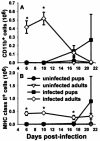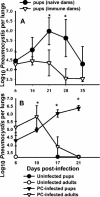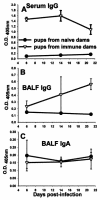Passive immunization of neonatal mice against Pneumocystis carinii f. sp. muris enhances control of infection without stimulating inflammation
- PMID: 15501746
- PMCID: PMC523030
- DOI: 10.1128/IAI.72.11.6211-6220.2004
Passive immunization of neonatal mice against Pneumocystis carinii f. sp. muris enhances control of infection without stimulating inflammation
Abstract
Pneumocystis carinii is an opportunistic fungal pathogen that causes life-threatening pneumonia in immunocompromised individuals. Infants appear to be particularly susceptible to infection with Pneumocystis. We have previously shown that there is a significant delay in clearance of the organisms from the lungs of neonatal mice compared to adults. Since alveolar macrophages are the effector cells responsible for killing and clearance of Pneumocystis, we have examined alveolar macrophage activity in neonatal mice. We found that alveolar macrophage activation is delayed about 1 week in Pneumocystis-infected neonates compared to adults. Opsonization of the organism by Pneumocystis-specific antibody resulted in increased clearance of the organism in neonatal mice; however, there was decreased expression of activation markers on neonatal alveolar macrophages and reduced levels of cytokines associated with macrophage activation. Mice born to immunized dams had significant amounts of Pneumocystis-specific immunoglobulin G in their lungs and serum at day 7 postinfection, whereas mice born to naive dams had merely detectable levels. This difference correlated with enhanced Pneumocystis clearance in mice born to immunized dams. The increase in specific antibody, however, did not result in significant inflammation in the lungs, as no differences in numbers of activated CD4+ cells were observed. Furthermore, there was no difference in cytokine or chemokine concentrations in the lungs of pups born to immune compared to naive dams. These findings indicate that specific antibody plays an important role in Pneumocystis clearance from lungs of infected neonates; moreover, this process occurs without inducing inflammation in the lungs.
Figures









Similar articles
-
Scavenger receptor A dampens induction of inflammation in response to the fungal pathogen Pneumocystis carinii.Infect Immun. 2007 Aug;75(8):3999-4005. doi: 10.1128/IAI.00393-07. Epub 2007 Jun 4. Infect Immun. 2007. PMID: 17548480 Free PMC article.
-
Exogenous heat-killed Escherichia coli improves alveolar macrophage activity and reduces Pneumocystis carinii lung burden in infant mice.Infect Immun. 2007 Jul;75(7):3382-93. doi: 10.1128/IAI.00174-07. Epub 2007 May 7. Infect Immun. 2007. PMID: 17485459 Free PMC article.
-
Delayed clearance of pneumocystis carinii infection, increased inflammation, and altered nitric oxide metabolism in lungs of surfactant protein-D knockout mice.J Infect Dis. 2004 Apr 15;189(8):1528-39. doi: 10.1086/383130. Epub 2004 Mar 30. J Infect Dis. 2004. PMID: 15073692
-
Mechanisms of defence in the lung: lessons from Pneumocystis carinii pneumonia.Sarcoidosis Vasc Diffuse Lung Dis. 2000 Jun;17(2):130-9. Sarcoidosis Vasc Diffuse Lung Dis. 2000. PMID: 10957761 Review.
-
Immunopathogenesis of Pneumocystis carinii pneumonia.Expert Rev Mol Med. 2005 Nov 14;7(26):1-16. doi: 10.1017/S1462399405010203. Expert Rev Mol Med. 2005. PMID: 16842636 Review.
Cited by
-
Novel pneumocystis antigen discovery using fungal surface proteomics.Infect Immun. 2014 Jun;82(6):2417-23. doi: 10.1128/IAI.01678-13. Epub 2014 Mar 31. Infect Immun. 2014. PMID: 24686066 Free PMC article.
-
Scavenger receptor A dampens induction of inflammation in response to the fungal pathogen Pneumocystis carinii.Infect Immun. 2007 Aug;75(8):3999-4005. doi: 10.1128/IAI.00393-07. Epub 2007 Jun 4. Infect Immun. 2007. PMID: 17548480 Free PMC article.
-
Exogenous heat-killed Escherichia coli improves alveolar macrophage activity and reduces Pneumocystis carinii lung burden in infant mice.Infect Immun. 2007 Jul;75(7):3382-93. doi: 10.1128/IAI.00174-07. Epub 2007 May 7. Infect Immun. 2007. PMID: 17485459 Free PMC article.
-
Immune modulation with sulfasalazine attenuates immunopathogenesis but enhances macrophage-mediated fungal clearance during Pneumocystis pneumonia.PLoS Pathog. 2010 Aug 19;6(8):e1001058. doi: 10.1371/journal.ppat.1001058. PLoS Pathog. 2010. PMID: 20808846 Free PMC article.
-
Immunization with Pneumocystis Cross-Reactive Antigen 1 (Pca1) Protects Mice against Pneumocystis Pneumonia and Generates Antibody to Pneumocystis jirovecii.Infect Immun. 2017 Mar 23;85(4):e00850-16. doi: 10.1128/IAI.00850-16. Print 2017 Apr. Infect Immun. 2017. PMID: 28031260 Free PMC article.
References
-
- Adkins, B. 1999. T-cell function in newborn mice and humans. Immunol. Today 20:330-335. - PubMed
-
- Adkins, B., and R.-Q. Du. 1998. Newborn mice develop balanced Th1/Th2 primary effector responses in vivo but are biased to Th2 secondary responses. J. Immunol. 160:4217-4224. - PubMed
-
- Adkins, B., and K. Hamilton. 1992. Freshly isolated, murine neonatal T cells produce IL-4 in response to anti-CD3 stimulation. J. Immunol. 149:3448-3455. - PubMed
-
- Berclaz, P. Y., Y. Shibata, J. A. Whitsett, and B. C. Trapnell. 2002. GM-CSF, via PU.1, regulates alveolar macrophage FcγR-mediated phagocytosis and the IL-18/IFN-γ-mediated molecular connection between innate and adaptive immunity in the lung. Blood 100:4193-4200. - PubMed
Publication types
MeSH terms
Substances
Grants and funding
LinkOut - more resources
Full Text Sources
Research Materials

